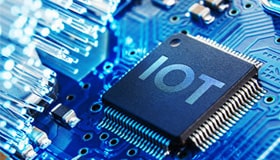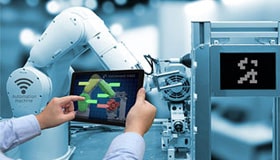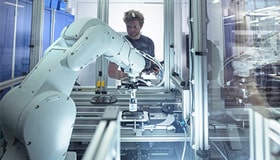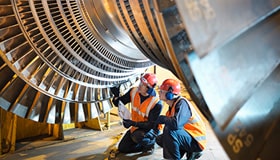Eyes and ears of IIoT – making equipment smarter than ever
The use of the internet of things (IoT) in industrial applications led to the evolution of the industrial internet of things (IIoT).
The IIoT enhances connectivity in critical applications such as industrial automation, security and surveillance, and building automation. Sensors are the eyes and ears of IIoT. These are integrated with equipment and objects, linked via wired or wireless networks, to improve productivity and adjust to varying conditions in real-time.
How sensors are making equipment smarter
Monitoring each stage of an assembly plant, where different components come together during various processing stages, will give you an in-depth idea of how fast the manufacturing should take place. The same applies to component suppliers; if they can use connected devices and replicate this procedure, then there's no need for the manufacturer or someone else downstream to adopt error-proofing steps.
The smart sensors that constitute a sensor network consist of intelligent devices such as motion detectors, temperature gauges, and vibration monitors. These devices detect changes in machinery conditions that reveal an impending failure, allowing maintenance scheduling before performance drops to unacceptable levels.
Advanced monitoring uses dashboards to provide real-time process measurements, machine status, and other data visualisation metrics to reach and even outperform the plant's operational objectives. As shown in Figure 1 of building blocks of the IIoT include sensors, a processor, a power source, and more.

Figure 1: The typical building blocks of the IIoT include sensors, processors, and other resources
Smart sensors have transformed the global manufacturing industry. The insights from collected shop floor data enable manufacturers to understand, measure, and optimize production. Sensors monitor each machine's energy use to help businesses deliver substantial cost and energy savings. Their use can yield an 80 percent reduction in costs whilst simultaneously increasing productivity by up to 20 percent.
Benefits of using sensors in manufacturing
Sensors help to improve product quality and decrease production costs whilst the business gains a new market. They provide the data for predictive maintenance alerts that increase process efficiency and help prevent malfunctions.
For example, a sensor can trigger an alarm if it detects changes in velocity or consistency on a production line. Problems are caught at their nascent stage and can be easily corrected, saving any downtime for the company. IoT data is collected at real-time speeds, allowing faster response times. The consequent increase in productivity allows easier management of supply chains. Predictive maintenance alerts save money because any potential malfunctions are detected and fixed before they occur. To know more about evolving predictive maintenance,(find out more).
The transition from analog to digital sensing
As traditional sensors evolve, they become smaller, more embedded, and competitively priced. The true nature of these sensors makes them limited in adaptability and functionality. For example, traditional industrial control generally uses transducers and transmitters as a basis of their physical parameter. The 4 – 20mA current loop transmitters dominate many industries. Unlike voltage-based output transducers, they deliver their measurements accurately over long cable lengths and are more immune to induced noise. The simple wiring and the 4mA minimum output current ensure easy detection of faults, such as a broken cable or sensor. However, despite this robustness, some limitations are present. The primary drawback is that the sensor electronics must draw less than 4mA of current. Additional power-drawing sensor features, including backlit displays and output relay options, are accommodated through a separate power supply. This often requires a move from 2-wire to 3-wire or 4-wire cabling. Another critical issue is that a single cable can only take in a single process signal. It means that masses of cables must handle many sensing signals. Such tasks put forward further challenges linked to ground loops if they are not properly isolated.
Digital technology has delivered a range of bus technologies suitable for industrial automation that allow many sensors to connect to a programmable logic controller (PLC) over a single cable length. Solutions leveraging the robust controller area network CAN communication protocol, such as DeviceNet, can support up to 64 nodes on a single network. Furthermore, cable lengths can reach up to 500m. This approach not only allows sensors to deliver process data to the PLC but the PLC to interrogate and configure the sensor too. The PLC could also reconfigure the sensor with differing ranges and limits for warnings or even request manufacturer ID, date, serial number, and hours of usage. The PLC may additionally form part of an IIoT-based maintenance checking solution.
Digital sensing
The miniaturization of silicon devices that draw exceptionally low power has spurred the move toward digital sensing. Such technological advancements have made possible new Micro-Electro-Mechanical Systems (MEMS) based sensing approaches (find out more). MEMS are tiny micrometer components etched into silicon. Compared with traditional analog alternatives, MEMS provides exceptional measurement accuracy. The move to digital sensing also benefits industrial applications Utilizing autonomous guided vehicles (AGV). Warehouses use wheeled robots to collect supermarket orders, with each robot wirelessly receiving instructions and sharing data. Fixed cabling is impossible as some manufacturing facilities migrate to more adaptive production environments. The same is replicated in the semiconductor industry, where a "conveyor belt" approach cannot efficiently fulfill the complex manufacturing process. The sector thus uses AGVs that collect silicon wafers from one processing station and deliver them (multiple times) to the next, roaming around the fabrication facility. Smart sensors (find out more) are a natural fit for such an IIoT digital wireless network ecosystem.
Sensors for IIoT applications
The physical parameter to be measured is specified initially, followed by the sensor. Learn more about selection criteria and industrial sensors. Many of us would instead use a finished, off-the-shelf sensor with standard mechanical housing, verified ingress protection (IP) levels, and predetermined integration of the appropriate industrial-grade signaling or network implementation. Some industrial sensing applications, on the other hand, may need the creation of a specialized sensor from the ground up. Not only must the detecting characteristics be specified appropriately, but so requires how the sensor will be positioned within its housing. Fortunately, today's packaging technology allows the fabrication of sensor assemblies that are no larger than the sensing element placed within them. This allows the sensing area to be close to the physical parameter being monitored, such as the temperature of a heating vessel. Multiple sensing methods may often be incorporated into a single device (Figure 2).
Along with the primary sensor, an accurate silicon-based temperature sensor is often embedded. Such devices are protected from generated and emitted noise sources due to their short paths and highly integrated circuitry whilst emitting little noise themselves. Conversion of analog signals into appropriate digital values, as well as power management and configuration functions, can be integrated onto a single chip and placed in the same package as the sensor. The non-volatile memory may allow configuration settings to be retained even when the power is turned off.

Figure 2: Highly integrated solutions convert analog sensor signals to a digital value, can process data using a low-power MCU, and may even support several sensor types in a single package.
Most component-level digital sensors provide configuration capability and share their measurements digitally through a board-level interfacing technology like SPI or I2C. It is essential to factor in the data transfer rate and the available bandwidth, particularly when connecting multiple sensors to the same bus. This design's selected microcontroller unit (MCU) must support the number of interfaces needed while being sufficiently powerful to execute fast-Fourier transform filters. The same holds if any pre-processing algorithms in conjunction with the industrial networking protocol stack communicate back to the selected PLC (Programmable Logic Controller).
IIoT sensors are transforming the manufacturing industry; Newark has partnered with many different suppliers catering to a wide range of Industrial Sensors and Sensor Connectors & Components products and solutions portfolios, such as Current Sensors, Environmental Sensors, Fibre Optic Sensors, Flow Sensors, Light Sensors, Industrial Wireless, Magnetic Sensors, Liquid Level Sensors, Motion Sensors & Position Sensors,Particle Sensors,Pressure Sensors Transducers, Proximity Switches, Temperature Sensors, Ultrasonic Sensors, Vibration & Shock Sensors are available to execute design, development and projects.






